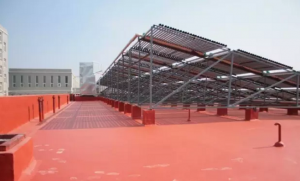Analyze the causes of deterioration of polyurethane waterproof coatings and effective solutions!
date: 2020-02-28 16:50:36Source: RG JIAYEViews: 1052

1. Any waterproof coating product has a shelf life. After this shelf life, problems will occur. So how to prevent the deterioration of polyurethane waterproof coatings? Let’s first understand why it deteriorates, and the reason for deterioration.
① The moisture content of the filler for production is too high;
② The production operation process (including the feeding sequence, reaction temperature and time, etc.) is out of control;
③ The thinner does not meet the requirements of urethane grade;
④ Air leakage in the paint packaging barrel, mixed with moisture or moisture in the air;
⑤ Reactive active substances, such as water, alcohol, acid, etc., accumulate in the packaging drum.
Prevention and solution:
① The specifications of the raw materials must meet the requirements of the formula and process, and the moisture content of the filler must be strictly controlled;
② Produce strictly according to the process conditions, and control the feeding sequence, reaction temperature and time within the specified range;
③ Do a good job of product packaging management and control of storage conditions.
2. Crust
The phenomenon of hard coating film forming on the surface of the coating during storage is called skinning. The reasons are:
① The seal of the paint packing drum is not tight or there is trachoma in the packing drum;
② Improper use of catalysts or excessive use of catalysts.
Preventive and preventive measures to prevent coatings from crusting:
① Use a suitable catalyst during production and strictly control the amount of catalyst;
② The paint packaging drum should be tightly sealed to prevent entry into the air;
③ Butanone oxime and cyclohexanone oxime can be added.
3. Precipitation
Pigment and resin are separated into two distinct layers. The phenomenon that the bottom pigment sometimes clumps and cannot be stirred is called precipitation. The reasons are:
① The viscosity of the coating is small, the amount of the diluent is too large, and the resin content is small;
② The relative density of the pigment is large, and the particles are too coarse;
③ Poor wettability of pigments;
④ The storage time is too long.
Prevention and solution:
① Add appropriate amount of anti-settling agent commonly used in coatings such as organic bentonite;
② Improve the fineness of pigments and add suitable pigment and filler wetting agents;
③ Periodically place the paint bucket upside down or horizontally during storage. Stir the paint evenly before use. It should be used within the specified time.
4. Hanging
When applied on a vertical facade, part of the paint flows downward, and a phenomenon similar to tears or curtains is called sagging. Causes of sag:
① Construction viscosity is too low;
② Use a solvent that is too volatile or too slow. Solvents that are too volatile are often volatilized before the coating film is completely leveled, and when solvents that are too volatile are used, the fluidity of the coating on the vertical plane is large, which will form tears or curtains;
③ The temperature at the construction site is too low or the humidity is too high;
④ The paint contains too much heavy pigment, and the wettability of the pigment is not good;
⑤ The coating is applied too thickly at one time.
Measures to prevent sagging during coating application:
① Properly increase the amount of thickener;
② Control the appropriate construction viscosity;
③ The construction environment temperature is preferably (20 ~ 30) ℃;
④ The coating film should not be too thick in one application, it is better not to exceed 0.5mm;
⑤ Adjust the volatilization speed of the diluent, and pay attention to the use of slow and fast volatilization solvents.








